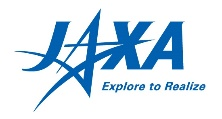 |
 |
株式会社ソニーコンピュータサイエンス研究所
国際宇宙ステーション・「きぼう」日本実験棟を利用した
長距離空間光通信軌道上実証について
国立研究開発法人宇宙航空研究開発機構(理事長:山川宏/以下、JAXA)と株式会社ソニーコンピュータサイエンス研究所(代表取締役社長:北野宏明/以下、ソニーCSL)は、将来の衛星間や地上との大容量リアルタイムデータ通信の実現を目指して、共同開発した小型衛星光通信実験装置「SOLISS」(Small Optical Link for International Space Station)を9月11日に打上げ予定の宇宙ステーション補給機「こうのとり」8号機で国際宇宙ステーション(ISS)へ送り届け、「きぼう」日本実験棟の船外実験プラットフォームを利用して軌道上実証を実施します。
本共同開発は、JAXA宇宙探査イノベーションハブの研究提案の枠組みを利用したもので、JAXAとソニーは光ディスク技術を利用した精密指向制御技術による長距離空間光通信技術の近距離での光通信実験を2016年から共同で行ってきました(※1)。軌道上での長距離光通信試験は、ISSの「きぼう」船外実験プラットフォームに設置されている中型曝露実験アダプター(i-SEEP)にSOLISSを設置し、1550nm帯のレーザーを用いて地上との通信試験を行います(※2)。2019年度中に実証実験を完了する予定です。
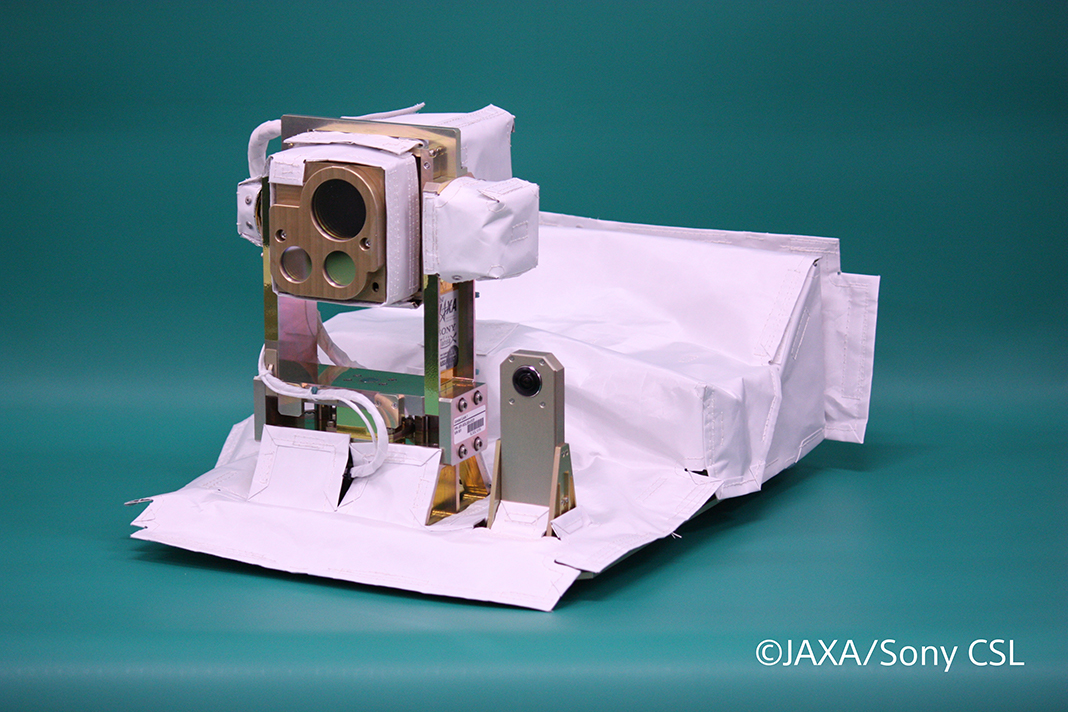 |
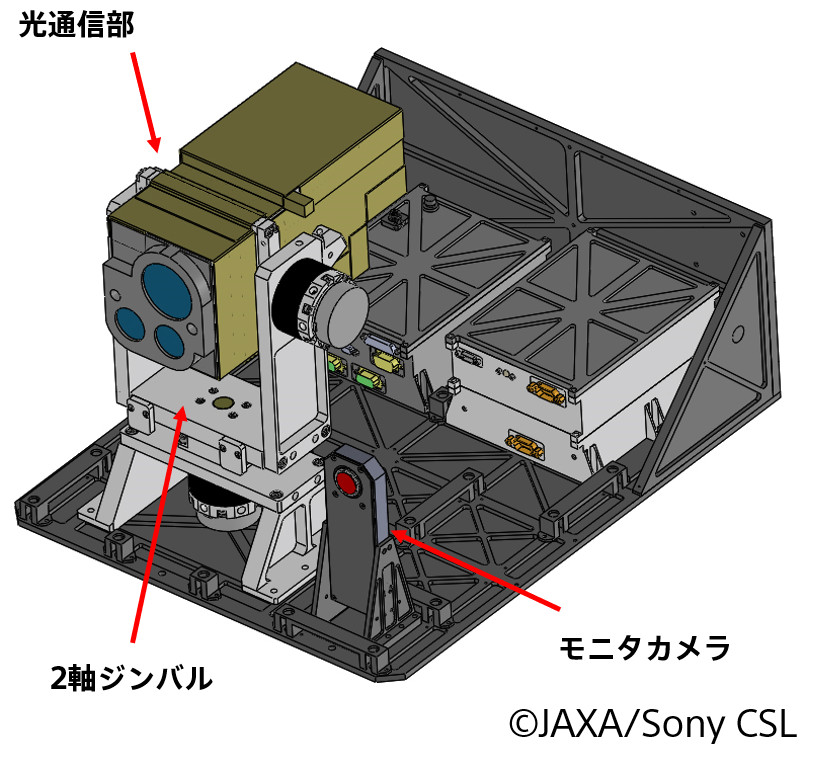 |
図1:SOLISSシステムFM(フライトモデル) |
図2:SOLISSシステムFM概要図 |
上図1、2に示すSOLISSは、光通信部、2軸ジンバルおよびモニタカメラ部分が外部に露出しており、そのほかは断熱材であるMLI(Multi-Layer Insulator)で覆われています。今回搭載した光通信部は、ソニーが1970年代より研究開発し、CDやMD,DVD,Blu-rayなどで事業化してきた光ディスク技術を用いており、高精度、低消費電力、小型で量産が容易であることなどを特徴としています。約1.2kgで断面のサイズは90mm x 100mmであり、内部には光ディスク技術を用いた小型の光制御機構が内蔵されています。双方向通信が可能であり、Ethernet規格を利用した接続により、宇宙においても地上のネットワーク同様に取り扱うことを想定したものになっています。
搭載されているモニタカメラは、2軸ジンバルの動作確認のため全天球カメラを採用しています。撮像した写真はISS経由で地上に送信するだけでなく、SOLISSの光通信を利用して地上に送ることも可能です。
※1 JAXAが国立研究開発法人科学技術振興機構から受託した「イノベーションハブ構築支援事業」(「太陽系フロンティア開拓による人類の生存圏・活動領域拡大に向けたオープンイノベーションハブ」)において、「長距離空間光通信を実現する光通信モジュールに関する研究」を共同して行う契約を2016年に締結。
※2 地上との通信試験は国立研究開発法人情報通信研究機構(NICT)の地上局と実施。
◆JAXA理事 若田光一のコメント
◆ソニーCSL社長 北野宏明のコメント
【本件に対する報道関係者からのお問い合わせ先】
- SOLISSについて 株式会社ソニーコンピュータサイエンス研究所コミュニケーションオフィス
- HTV8搭載及びISSでの宇宙実証について 国立研究開発法人宇宙航空研究開発機構 広報部
Email:csl-pr@csl.sony.co.jp
 |
 |
Japan Aerospace Exploration Agency (JAXA)
Sony Computer Science Laboratories, Inc.
The Japan Aerospace Exploration Agency (JAXA, President: Hiroshi Yamakawa) and Sony Computer Science Laboratories, Inc. (Sony CSL, President and CEO: Hiroaki Kitano) today announced their plans to conduct in-orbit demonstrations of the long-distance laser communication system, which they have jointly developed with the aim of establishing a real-time, mass-data communication system for future inter-satellite communications and communications with ground stations. The system, currently known as Small Optical Link for International Space Station (SOLISS), will be carried aboard the H-II Transfer Vehicle (HTV8) “KOUNOTORI-8”, the cargo transporter to the International Space Station (ISS), which is scheduled for launch on September 11th, 2019. The in-orbit demonstrations will be conducted using the Exposed Facility of the Japanese Experiment Module (JEM) “Kibo”.
Since 2016, JAXA and Sony have jointly conducted ground demonstrations of this long-distance laser communication technology which uses an optical disk technology for fine pointing, under the Request for Proposal (RFP) joint study framework of the JAXA Space Exploration Innovation Hub Center.*1 In the upcoming in-orbit long-distance laser communication demonstrations, the SOLISS system will be attached to the IVA-replaceable Small Exposed Experiment Platform (i-SEEP) hardware adapter installed on the JEM’s Exposed Facility to perform ground-to-low earth orbit (LEO) optical communication testing using a 1550 nm bandwidth laser.*2 JAXA and Sony plan to complete the demonstrations within fiscal year 2019.
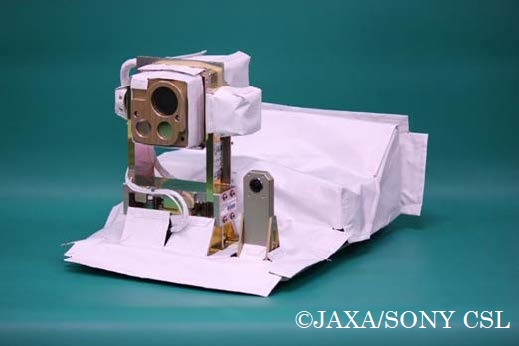 |
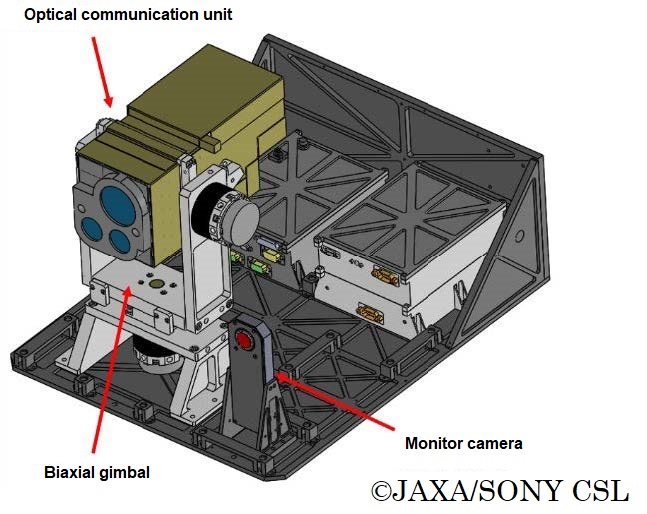 |
Figure 1: SOLISS system flight model |
Figure 2: SOLISS system flight model overview |
As shown in figures 1 and 2 above, the SOLISS system has an optical communication unit, a biaxial gimbal, and a monitor camera that are partially exposed to space, while the rest is covered with a multi-layer heat insulator. The optical communication unit employs Sony’s optical disk technology, which is the fruit of Sony’s development starting in the 1970s and commercial applications such as CDs, MDs, DVDs, and Blu-ray discs. The optical disk technology is high-precision, low power, compact, and mass production capable. The optical communication unit weighs approximately 1.2 kg, has a cross-sectional area of 90 mm x 100 mm, and is equipped with a built-in small optical control mechanism using optical disk technology. The unit is capable of bidirectional communication and can be operated in the same way as a terrestrial network, even in space, supporting an Ethernet protocol.
The monitor camera employs an omnidirectional camera to observe the operation of the biaxial gimbal. The photos taken can be sent to the ground not only via the ISS but also using SOLISS’s laser communication directly.
According to a statement by Vice President Koichi Wakata of JAXA, “The upcoming demonstration of long-distance laser communication technology will mark the first in-orbit demonstration for the Space Exploration Innovation Hub Center, and we have very high expectations for this technology. This technology, which employs a laser for in-orbit mass-data communication, will likely be widely used not only in the telecommunications industry, but in the future as a means of communication in the field of exploration. Specifically, it can be used as a means of communication between the Earth and the International Space Station, the Moon, and Mars. There is a wide range of potential applications, such as communication with the Moon rovers. I am confident that the utilization of the Japanese Experiment Module “Kibo” will enable the timely demonstration of the SOLISS system in space. Going forward, the results of these demonstrations will contribute to the telecommunications industry on Earth and to the future exploration missions in space.”
President Kitano of Sony CSL remarked, “Long-distance laser communication technology enables transformation of our society with real-time broad-band communication around the globe as well as expanding the humanosphere and increased activity in space. Sony CSL is taking advantage of the in-orbit demonstrations to complete our long-distance laser communication system. It will be the first step for Sony to build upon the results of these demonstrations and put it into practical use in society as we commercialize it. The opportunity to use Kibo for the in-orbit demonstrations makes it possible to greatly advance the research and development of the optical communication system, much more quickly than if we had launched a small satellite for the same purpose on our own. The SOLISS system is built using consumer components. After the demonstrations, we will retrieve the SOLISS unit and perform follow-up analyses, which we expect will further accelerate our commercialization process.”
*1 Studies implemented based on the JAXA-Sony agreement concluded in 2016 for conducting fundamental and feasibility studies on long-distance communication system with free-space laser link technologies as part of JAXA’s “Open Innovation Hub for Expanding Humanosphere and the Domain of Human Activity through Solar System Frontier Development,” a project commissioned by the Japan Science and Technology Agency (JST) under its innovation hub start-up support program.
*2 Communication tests with the ground are conducted with ground stations of Japan’s National Institute of Information and Communications Technology (NICT)
Media inquiries:
- Inquiries about SOLISS Communications Office, Sony Computer Science Laboratories
- Inquiries about International Space Station (ISS) and HTV8 “KOUNOTORI8” mission Public Affairs Department, the Japan Aerospace Exploration Agency
csl-pr@csl.sony.co.jp
https://global.jaxa.jp/activity/pr/inquiries/index.html